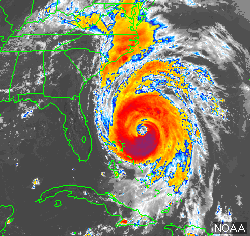
At 5 a.m. the National Hurricane Centre in Miami said Danny’s maximum sustained winds had increased from 75 to 85 miles per hour. It was located about 985 miles east southeast of the Leeward Islands and moving towards the west northwest at 10 miles per hour, and interests in that part of the Caribbean have been advised to monitor its progress.
“This general motion is expected to continue during the next day or so. A turn toward the west is forecast by Saturday night . . . Some additional strengthening is possible today, but Danny should begin to weaken on Saturday,” the NHC said.
Danny is expected to reach the Leeward Islands on Monday as a storm, but forecasters say conditions in the Caribbean are less favorable for development – higher winds and drier air could cause it to lose steam.
A weakened Danny could also bring rainfall to drought-hit Puerto Rico, as well as the Virgin Islands early next week.
Danny is still a small hurricane, with hurricane force winds extending outward up to 10 miles from the center and tropical storm force winds extending outward up to 60 miles.
Danny is the first hurricane of the 2015 Atlantic hurricane season.
Tropical storms Ana, Bill and Claudette were the first named systems. The first two touched down on the US coast with little to no damage while Claudette fizzled in the Atlantic before making landfall.
While most people across the region are focusing on Danny, forecasters are watching a broad area of low pressure a couple hundred miles south southwest of Bermuda that is interacting with an upper-level low and is producing disorganized showers and thunderstorms.
The NHC says environmental conditions could support some tropical or subtropical development while the system moves slowly northward over the western Atlantic Ocean through the weekend.
There is a low – 20 percent – chance of formation in the next 48 hours, but a medium – 60 percent – probability that formation could happen within the next five days.
Read more at caribbean360.com


